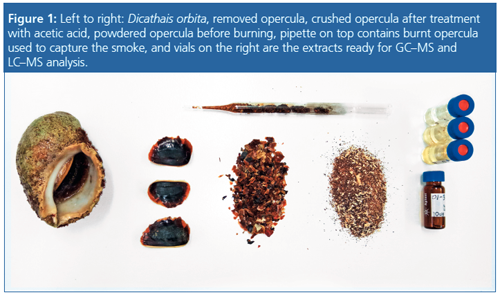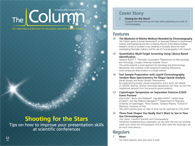The Mysteries of Marine Molluscs Revealed by Chromatography
The Column spoke to Kirsten Benkendorff, an Associate Professor in Environment, Science, and Engineering and the Co-Deputy Director of the Marine Ecology Research Centre at Southern Cross University in Australia, about her work investigating Muricidae molluscs, their use in ceremonial incense and traditional medicines, and the role of chromatography in this research.
Photo Credit: Cherdchai Chaivimol/Shutterstock.com

The Column spoke to Kirsten Benkendorff, an Associate Professor in Environment, Science, and Engineering and the Co-Deputy Director of the Marine Ecology Research Centre at Southern Cross University in Australia, about her work investigating Muricidae molluscs, their use in ceremonial incense and traditional medicines, and the role of chromatography in this research. -Interview by Kate Mosford
Q. Your group has been studying volatile and bioactive compounds in opercula from Muricidae molluscs used in traditional medicine and religious ceremony (1). Why did your group decide to focus on this type of mollusc?
A: My research on Muricidae molluscs started with my PhD way back in 1995 when I was examining the antibacterial properties of mollusc egg masses. I found some unusual brominated indoles in the Muricidae species, which piqued my interest, and when I discovered they were precursors of the historically important shellfish dye Tyrian purple I was hooked! I have spent the last 20 years investigating the anticancer and anti-inflammatory properties of these compounds from the purple secreting gland, but only recently came across some historical literature which indicated that the opercula on the foot of the snails was also used in traditional medicine (2–6). Some of these texts describe burning the opercula and using the smoke for fumigation, and it became apparent that this was used for both medicinal and spiritual applications and is still used in some cultures today.

Q. Can you tell us about the role of chromatography in this project?
A: We used both gas chromatography (GC) and liquid chromatography (LC) coupled with mass spectrometry (MS) to separate and characterize the small organic compounds in the opercula. GC–MS was used to characterize the volatile compounds found in the opercula smoke, whereas LC–MS was used on methanol and hexane extracts of the opercula to analyze compounds more likely to be extracted in alcoholic or oil extracts used in traditional preparations. Finally, we used preparative high performance liquid chromatography (HPLC) to purify a couple of compounds for confirmation of the structures by nuclear magnetic resonance (NMR).
Q. What were the biggest challenges from an analytical chemistry perspective?
A: As with all exploratory research, one of the major challenges was that we didn’t know what sort of compounds we were looking for, thus making it hard to select optimal procedures. Consequently, we just had to try a few different approaches and then refine the methods to get better peak separation.
Another challenge was the really low sample availability of one species (Chicoreus ramosus) that we obtained from overseas because it has been described as the best for fumigation. We only had three opercula from this species and only a tiny amount of extract was obtained from the smoke for analysis. We initially failed to detect anything by GC–MS with these smoke samples and had to adapt an LC–MS approach, where we could inject a greater volume of sample. We optimized this using our Australian model species Dicathais orbita and were able to detect the phenolic compounds, which we then confirmed were also present in Chicoreus opercula.
Q. What were your main findings?
A: We were able to demonstrate the presence of volatile phenols in the opercula smoke extracts including chlorinated phenols, which have a medicinal smell and could have contributed to the traditional use for ritualized cleansing with holy incense. We also detected a range of bioactive compounds that could contribute to the ethnomedicinal applications of opercula preparations. These included the brominated indole precursors of Tyrian purple, which have anticancer, anti-inflammatory, and steroidogenic properties, consistent with the use of opercula for women problems, skin diseases, tumours, and arthritis. We also found evidence of the muscle-relaxing choline ester murexine in the opercula alcoholic extracts, which is consistent with traditional use of opercula medicine for epilepsy, dislodging the placenta after labour, and pain in general.
Q. Were there any results that surprised you?
A: The detection of the precursors to Tyrian purple in the opercula extracts was surprising because these compounds are biosynthesized and stored in a specialized gland within the mantle cavity of the snails. It is unclear how or why the compounds are transported to the opercula, but they may just be absorbed fortuitously when the snail secretes the compounds for reproduction or feeding.
Another interesting finding was the importance of traditional methods for preparing the opercula before burning for fumigation. We detected high levels of the toxic compound pyridine in smoke extracts from untreated opercula, but this compound was removed, along with the “fishy” smell, by soaking the opercula in alcohol or acetic acid (vinegar).
Q. Why has there been controversy over the identity of onycha/operculum in sacred incence?
A: Mostly it is accepted that onchya, the fourth ingredient in holy incense, is derived from mollusc opercula. However, this has been debated on the grounds that marine molluscs are included amongst the unclean animals and indeed are described as “abominations” in some translations of the Holy Bible. Thus is has been argued that molluscs could not be used for such holy purposes. However, this ignores the fact that the Muricidae molluscs were used as a source of purple and blue dye used to adorn the tabernacle in churches, robes worn by high priests, and tassels in prayer shawls.
The only other argument against the mollusc opercula as the source of onchya was the lack of evidence for an agreeable odour. Indeed the opercula do not smell nice when burnt, unless pretreated with traditional methods by soaking in alcohol or vinegar. Furthermore, the role of onchya in incense is mostly to prolong the scent and it does leave a lingering musky but mildly antiseptic smell when burnt after treatment. Our detection of antioxidant and chlorinated phenols is consistent with this role.
Q. Could any of the analytes you identified be used in commercial products?
A: The smoke extracts of the opercula were dominated by phenol and para-cresol, which are very common antioxidants often included as ingredients in perfumes. We also detected some acetamide, which is often used in cosmetics. The chlorinated phenols we detected are less likely to be included as a synthetic ingredient in perfumes and thus provide a possible marker for confirming whether onchya from Muricidae opercula has been incorporated in commercial incense or perfumes that claim to use this rare natural ingredient.
With respect to the bioactive ingredients found in the Muricidae opercula, the brominated indole derivatives and choline esters that we detected are not commercially available. There is a homeopathic product produced from the purple secreting gland that may contain some of these compounds in the original tincture, but in practice, the formulation would be so dilute that no traces of the bioactive compounds would remain.
Q. What are you working on next?
A: My ongoing research programme is investigating the potential for developing an optimized and properly substantiated nutraceutical from the Muricidae. We have a standardized LC–MS method for quantitative analysis of the bioactive compounds. Preclinical testing of the extracts for antiâinflammatory activity is underway using a range of in vivo models and in vitro assays for mechanism of action. We are also investigating xenotoxic metabolism of the natural extract in comparison to a pure compound, using mass spectrometry imaging to track in situ absorption, distribution, and metabolism of indole derivatives.
Another aspect of my research programme is focused on the impacts of ocean climate change on marine molluscs. Using a standardized LC–MS method for quantitative analysis, we are able to test the effects of elevated seawater temperature, pCO2âinduced acidification, and other possible environmental stressors on Muricidae secondary metabolites. We are also using GC–flame ionization detection (FID) for fatty acid methyl ester analysis to assess the impacts of future oceanic conditions on omega-3 and -6 polyunsaturated fatty acids in a range of seafood species.
References
- B.D. Nongmaithem, P. Mouatt, J. Smith, D. Rudd, M. Russell, C. Sullivan, and K. Benkendorff, Scientific Reports7, 17404 (2017).
- K. Benkendorff, D. Rudd, B.D. Nongmaithem, L. Liu, F. Young, V. Edwards, C. Avila, and C.A. Abbott, Marine Drugs 13(8), 5237–5275 (2015).
- M. Meyerhof and G.P. Sobhy, The Abridged Version of “The Book of Simple Drugs”, of Ahmad Ibn Muhammad Al-Ghafiqi by Gregorius Abul-Farag (Al Ettemad Printing Press and Publishing House, Cairo, Egypt, 1932), pp. 224–228.
- E. Lev and A. Zohar, Practical Materia Medica of the Medieval Eastern Mediterranean According to the Cairo Genizah (Brill Online Books and Journals, Leiden, The Netherlands, 2008), Volume 7, p. 664.
- M. Levey, J. His. Med. All. Sci. 16, 394–410 (1961).
- H.S. Guan and S.G. Wang, in Zhong Hua Hai Ben Cao (Chinese Marine Materia Medica) (Shanghai Science and Technology Publishing House, Shanghai, China, 2009), Volume 3, pp. 154–171.

Kirsten Benkendorff is an Associate Professor in Environment, Science, and Engineering and the Co-Deputy Director of the Marine Ecology Research Centre at Southern Cross University (Australia). She is an interdisciplinary researcher focused on assessing the bioresource value of marine molluscs. She has successfully supervised 18 PhD, 3 Masters, and 31 Honours students. Kirsten has published six invited book chapters and 92 papers in international peer-reviewed scientific journals. She is Associate Editor for Scientific Reports and Collection Editor for the Marine Drugs topical collection on Bioactive Compounds from Marine Invertebrates. In recognition of her contributions to marine science, Kirsten was awarded the 2011 Dorothy Hill Award from the Australian Academy of Science, the 2008 SA Young Tall Poppy Award, and the 2000 Young Australian of the Year Award in Science and Technology.
E-mail:Kirsten.benkendorff@scu.edu.auWebsite:https://www.scu.edu.au/research-centres/marine-ecology-research-centre/researchers/dr-kirsten-benkendorff/#d.en.127967

Common Challenges in Nitrosamine Analysis: An LCGC International Peer Exchange
April 15th 2025A recent roundtable discussion featuring Aloka Srinivasan of Raaha, Mayank Bhanti of the United States Pharmacopeia (USP), and Amber Burch of Purisys discussed the challenges surrounding nitrosamine analysis in pharmaceuticals.
Silvia Radenkovic on Building Connections in the Scientific Community
April 11th 2025In the second part of our conversation with Silvia Radenkovic, she shares insights into her involvement in scientific organizations and offers advice for young scientists looking to engage more in scientific organizations.

.png&w=3840&q=75)

.png&w=3840&q=75)



.png&w=3840&q=75)



.png&w=3840&q=75)










